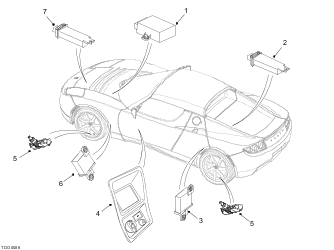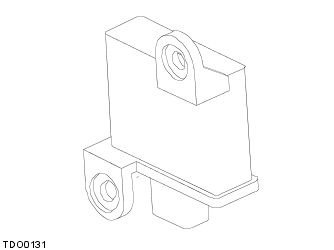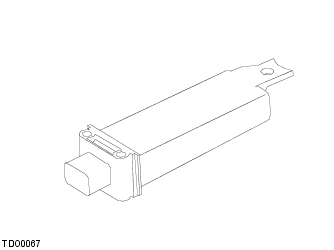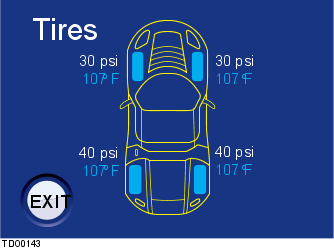
- Tire Pressure Monitoring System (TPMS) ECU
- TPMS trigger module – rear
- TPMS antenna module – rear
- Touch screen
- TPMS wheel sensors (x4)
- TPMS antenna module – front
- TPMS trigger module – front
Tire Pressure Monitoring System (TPMS)

The vehicle features a Tire Pressure Monitoring System (TPMS) that monitors both the air pressure and temperature of each tire and transmits this information via a Radio Frequency (RF) signal to an antenna and on to a central ECU.
In the event of the air pressure in a single or multiple tires falling below a prescribed value, a message is sent to the touch screen and the driver is warned via a warning lamp within the instrument pack.

The valve stem is secured to the moulded sensor using the retaining screw and is sealed with an O-ring. This sensor fits through the valve hole in the wheel rim, is secured with the valve nut and is sealed with an O-ring. The curvature of the sensor follows the form of the wheel rim.
The wheel sensor contains a filter to allow it to operate accurately without contamination by water vapour or dirt. The sensor also contains a pressure sensor, a signal processor and a RF antenna. A temperature sensor is incorporated to compensate for variation in temperature which may affect pressure readings. The sensors are fitted with lithium-ion batteries which have a service life of up to 10 years.
The wheel sensors have a pressure measurement range of 7.25 psi to 92.5 psi (0.5 bar to 6.3 bar) and a temperature operating range of -40°F to +248°F (-40°C to +120°C).

A waterproof, impact protected trigger module is located in each of the four wheel arches. Each trigger module has a 4-pin connector providing a connection to either the front or rear harness. Each trigger module has a wired connection to the TPMS ECU.

Two antenna modules are fitted to the vehicle, one to the underside of the front crash structure and the other to underside of the trunk box. They each contain a 433 MHz RF receiver, a data de-modulator and a data decoder. The antenna modules are connected to the TPMS ECU.
The TPMS ECU is located behind the LH side of the dash board, above the touch screen, connected to the front harness. The instrument pack incorporates an amber warning lamp with an associated warning on the touch screen.
If a drop in tire pressure is detected, if the tires overheat or if there is a fault with the system, the Tire Pressure Monitoring System (TPMS) warning lamp, located within the instrument pack will illuminate. The warning lamp is accompanied by a message on the touch screen.
| WARNING: The TPMS is not a substitute for correct tire maintenance and cannot register damage to a tire. It is the driver’s responsibility to maintain correct tire pressure, even if under-inflation has not reached the level to trigger illumination of the TPMS warning lamp. |
| CAUTION: Driving on a significantly under-inflated tire causes the tire to overheat and can lead to sudden tire failure. Under-inflation also reduces fuel efficiency and tire tread life and may affect the vehicle’s handling and braking ability. |
The wheel sensors comprise three integrated circuits. One measures the analogue values for pressure, temperature and acceleration and coverts them into digital values. The acceleration value is used to determine when a vehicle is in motion. A secondary circuit comprises a 433 MHz transmitter. A third circuit initiates the system using a trigger signal of 125 kHz.
The wheel sensor receives commands over a wireless Low Frequency (LF) link from the trigger modules which instruct it when to transmit information to the antenna modules. The wheel sensor transmits pressure and temperature data over a wireless Radio Frequency (RF) link to the antenna modules. Error protection of the transmitted signal is provided by a cyclic redundancy check algorithm.
When the key is turned to the ON position, the trigger modules receive data from the TPMS ECU to generate the trigger data and the RF signal generator. Each trigger module in turn forces its corresponding wheel sensor to transmit data to the antenna modules to determine each wheel sensor position on the vehicle. Pressure and temperature measurement cycles vary depending on the trigger modules. The RF used to transmit the signal is approximately 125 kHz ensuring that the range of the signal results in reliable control of the wheel sensors, enabling exact identification of each wheel sensor. If there has been any change in status, e.g. new wheels fitted, the system will 'learn' the location of the new wheel sensor.
The two antenna modules receive data from each wheel sensor. These signals are converted to an intermediate filtered frequency of 10.7 MHz. This signal is then demodulated, decoded and reformatted and transmitted to the TPMS ECU.
The TPMS ECU uses the signals from the antenna modules, to alert the driver to a tire pressure warning both by illuminating the TPMS warning lamp in the instrument pack and by creating a message on the touch screen. This will occur if:
The touch screen displays the information received from the antenna modules via the TPMS ECU. To view the tire information:

The Tires screen shows a temperature and pressure reading, from each wheel sensor, adjacent to the respective wheel. A blue wheel indicator indicates an acceptable operating pressure for the tire. A red wheel indicator indicates that the pressure is either below or in excess of recommended operating pressure.
The vehicle is fitted with a TPMS warning lamp in the instrument pack to indicate when the system is not operating correctly. When the system detects a malfunction, the warning lamp will flash for approximately 90 seconds and then remain continuously illuminated. This sequence will continue upon subsequent vehicle start-ups as long as the malfunction exists. When the warning lamp is illuminated, the system may not be able to detect or signal low tire pressure as intended. TPMS malfunctions may occur for a variety of reasons including the installation of replacement or alternate tires or wheels on the vehicle that prevent the TPMS from functioning correctly.
Always check the TPMS malfunction warning lamp after replacing one or more tires or wheels to ensure that the replacement or alternate tires and wheels allow the TPMS to continue to function properly.